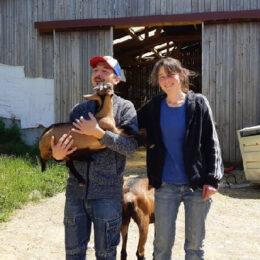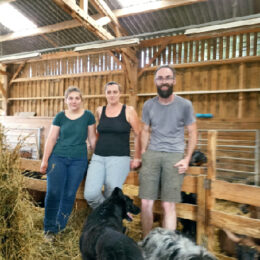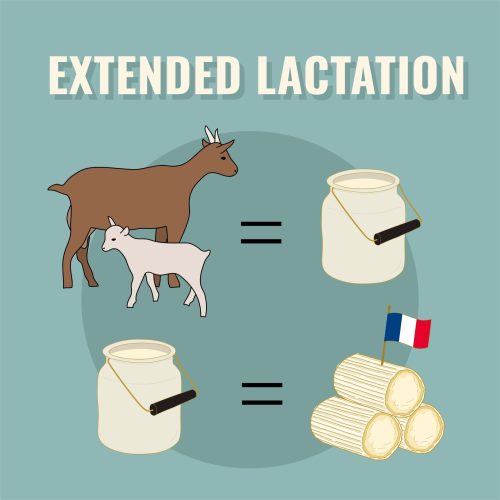
We have already covered this topic in our Misconception Sheet “Dairy cows spontaneously produce milk all year round, TRUE or FALSE?“: mammals do not spontaneously produce milk and must give birth to a young to do so. So in order to make cheese from cow, sheep or goat milk, these must breed periodically.
The Chaire Bien-Être Animal keeps you up to date, focusing on the practice of extended lactation, which offers a number of advantages. We also gave the floor to two breeders who practice extended lactation on part of their herds. They explain their approach and share their observations in the field. These practices look promising, with implications in terms of animal health and welfare.

Keep in mind
- Lactation implies the birth of kids. However, the French do not eat much kid goat meat
- Increasing lactation duration in goats may be useful for reducing the number of kid births while maintaining milk production
- Extended lactation in goats is also possible for other reasons, such as reproduction management, the distribution of milk production throughout the year, breeder work organization, etc
We have already covered this topic in our Misconception Sheet “Dairy cows spontaneously produce milk all year round, TRUE or FALSE?“: mammals do not spontaneously produce milk and must give birth to a young to do so. So in order to make cheese from cow, sheep or goat milk, these must breed periodically.
The Chaire Bien-Être Animal keeps you up to date, focusing on the practice of extended lactation, which offers a number of advantages. We also gave the floor to two breeders who practice extended lactation on part of their herds. They explain their approach and share their observations in the field. These practices look promising, with implications in terms of animal health and welfare.
Goat cheese and meat consumption
The French do fancy goat cheese, but they don't eat much kid goat meat...
The French love goat cheese: France is the world’s leading producer of goat cheese, with over 130,000 tonnes of cheese produced annually – 80% of which is consumed locally[1]. According to the National Federation of Goat Farmers (FNEC), French households consumed an average 2.6 kg of goat cheese in 2020[2].
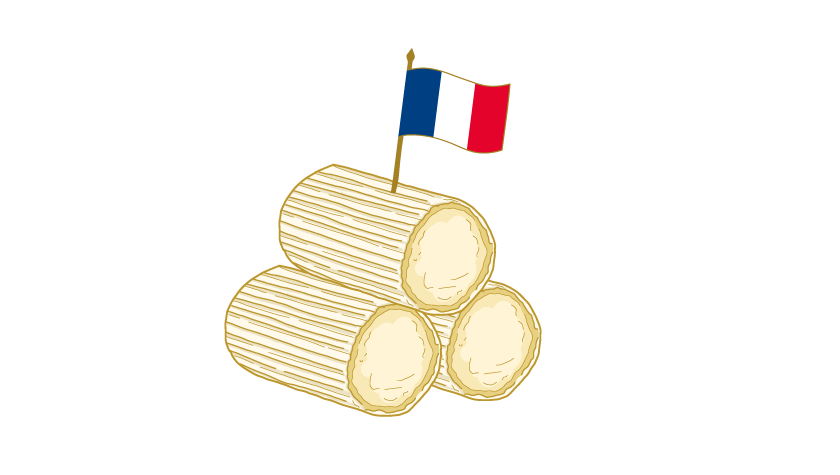
In France, goats are mainly raised for their milk, much less for their meat – which is difficult to promote, knowing that only kid goat meat is consumed in France. In 2017, out of 1,160,000 kid goats that were born and reached the age of two months[3], 300,000 females were used to renew the herds and 550,000 males were slaughtered to supply the meat industry. Only 8,000 live goats were exported, mainly kids for breeding. Note that 55% of French kid goat meat production is exported, mainly to Portugal and Italy[4]. Finally, 300,000 kids were neither kept for breeding nor slaughtered after fattening: this may be due to the overestimation of birth numbers, a share of self-consumption, early mortalities, etc.[5]
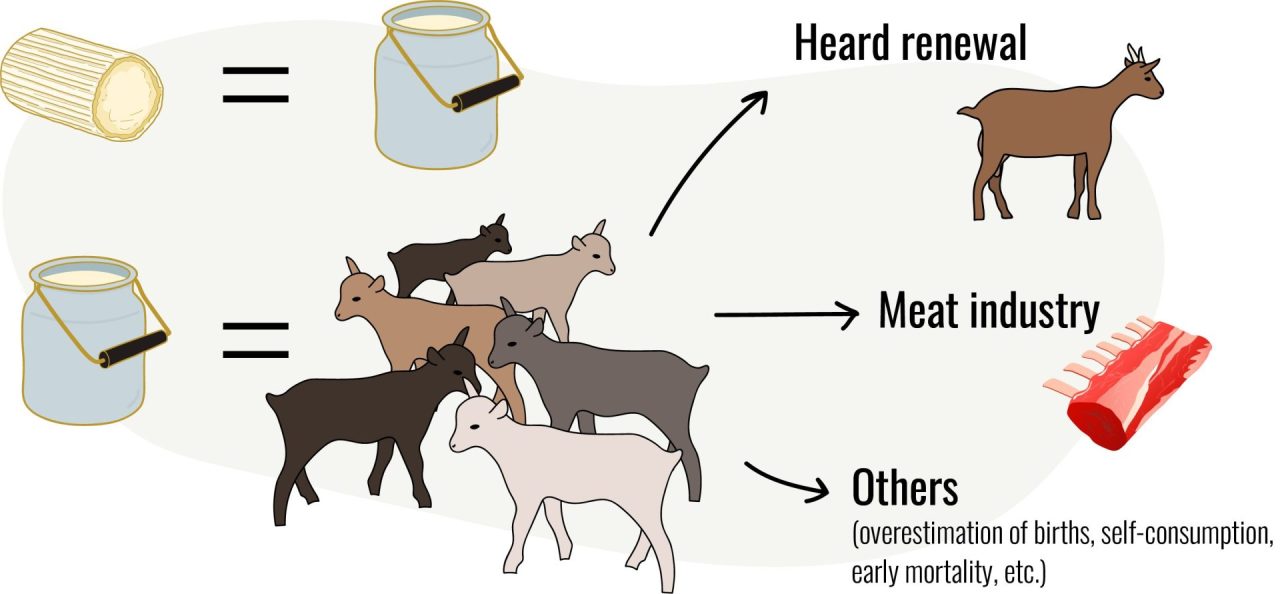
The fate of kid goats
… which can create challenges for marketing kid goats
According to a 2021 report from the General Council for Food, Agriculture and Rural Areas (CGAAER )[6],the Covid crisis revealed and exacerbated structural difficulties in the goat industry.
First, kid goat meat has low economic value and is in decline: the average purchase price from breeders is currently less than 4 euros per kid, against 7 euros in 2019. Also, outlets for kids are shrinking with a decrease in meat consumption in France and increasing competition from exporting countries (such as the Netherlands, Greece, Spain or Romania). Finally, the market is very seasonal, with consumption peaks at Easter, Christmas or other religious holidays, while births are concentrated at the beginning of the year (72% of births). This requires freezing and storing a large portion of total kid meat until consumption. In France under Covid, slaughterhouses were no longer able to store frozen kid goat meat[7] and therefore to slaughter new kids.
Hence a paradox
In order to meet consumer demand for goat milk and cheese, it is necessary to breed kids to maintain lactation and ensure herd renewal. However, only 20 to 30% of births are needed for this purpose[8] and the remaining kids’ market value is weak. What is more, the entire goat industry feels concerned by a very strong risk linked to animal welfare: kid goats generate emotion and empathy, and their slaughter is sometimes badly received by society[9].
An answer to several breeding objectives
Extended lactation can meet several breeding objectives
If the promotion of kid goat meat seems essential, CGAAER recommends reducing kid goat production to a certain extent[10]. Among the tools it put forward in a September 2021 note, extended lactation may be useful: “To reduce the number of kids quickly, the development of extended lactation in dairy goat farms may be the easiest means available” [11].
Certainly, extended lactation is implemented for various reasons and objectives dealing with reproduction management, distribution of milk production throughout the year, organization of the breeder’s work, etc.[12] But it can also be interesting for reducing the number of births while maintaining milk production, and therefore cheese production, all year round.
In France, this has been a fairly widespread practice since the 1990s. In 2020, it was estimated that around 20% of goats were concerned by extended lactation[13], knowing that goats can experience one[14] or several extended lactation periods in their career, at different times in their lives: 30% of extended lactation periods occur during first lactation, 20% in mid-career and approximately 20% at the end of career[15].
How does it actually work?
Extended lactation comes in many forms. Usually, in normal lactation, the goat’s milk production cycle is as follows:
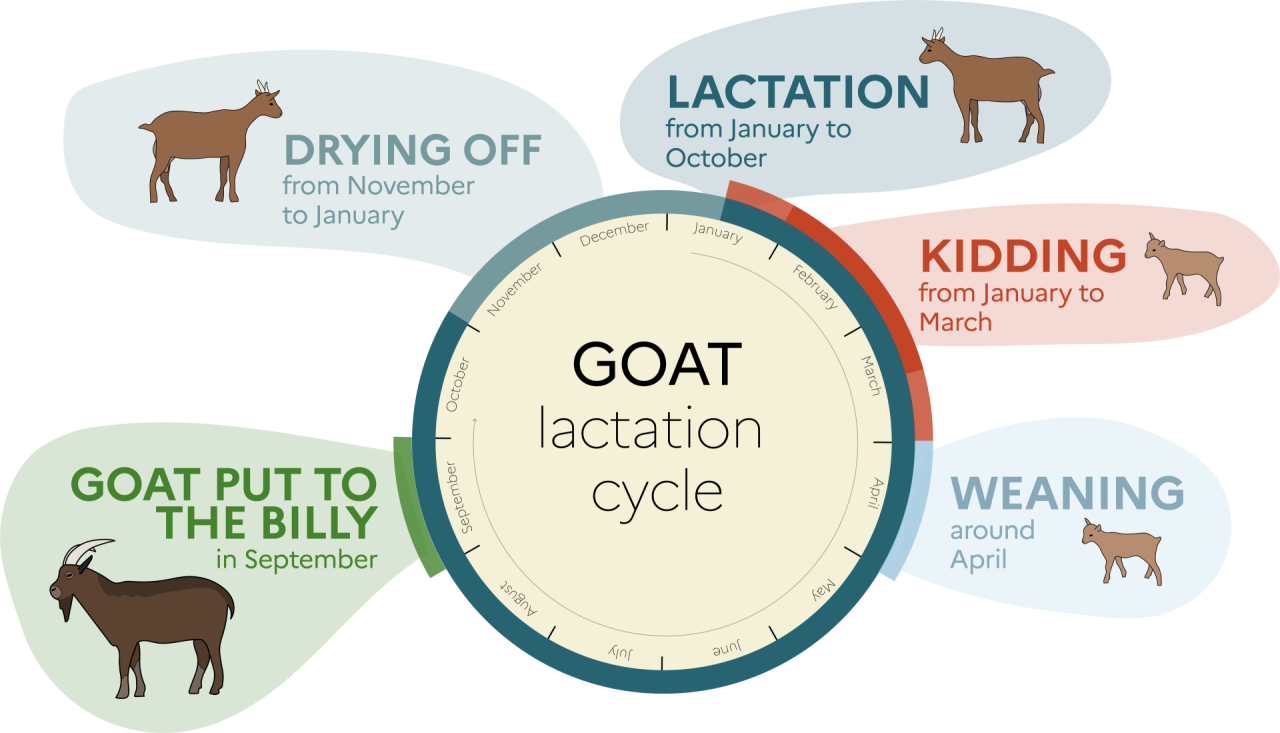
The lactation period lasts approximately 10 months, followed by a drying off period of 2 months before the next birth. Extended lactation consists of continuing to milk the goat without putting it to the billy every year.
Extended lactation, when everything goes well, therefore consists in having the goat produce milk over a period of more than 16 months and on average more than 700 days without births. This has the advantage of maintaining milk production throughout the year, while reducing the number of kids. In terms of livestock management, this also allows to organize work differently during the birthing season: fewer births means less work around kidding and raising the kids, which means more care for the animals. Milk production spread over the year also allows milk to be sold and/or cheese to be produced all year round, smoothing out cash flow.
It should be noted that extended lactation is not always possible or successful for all goats: it depends on their characteristics and capacities (level and persistence of milk production, state of health, etc.), as well as the context. Some goats do not maintain enough milk to ensure extended lactation. Also, extended lactation isn not necessarily chosen, or part of a breeding strategy: it is sometimes endured, resulting from reproductive failures typically.
Impacts on milk production, health and mortality?
What are the impacts on milk production, health and mortality?
If extended lactation seems promising in order to reduce births, what about its impact on milk production, health, and the longevity of goats?
As far as milk production is concerned, extended lactation over 700 days has no significant impact on the amount of milk produced over a goat’s career. But it is accompanied by higher fat and protein content in the milk compared with conventional lactation, which increases cheese yield without altering milk taste[16]. However, these observations need to be consolidated by other scientific studies and adapted to the French context in particular. To ensure extended lactation is successful and avoid natural drying off, it is recommended to favor goats that have a good level of milk production [17].
Regarding goat health, it seems that the frequency of clinical mastitis is not increased in extended lactation[18]. However, during extended lactation, a deterioration of milk cell concentrations is observed[19], reflecting subclinical mastitis. However, this does not affect all goats[20].
One major recommendations is to choose goats with good udder health. Those with persistent infections may need to be dried off (and therefore put out of extended lactation).
As for the mortality rate of goats, lower mortality rates are observed in herds with extended lactation, which can probably be explained by the reduction of risks associated with parturition[21].
Finally, it should be noted that it remains necessary to breed goats that have the best genetic potential in order to ensure herd renewal. That being said, goats that have good characteristics for maintaining extended lactation are generally also those with the best potential. It is therefore necessary to find a good balance between reproduction and extended lactation.
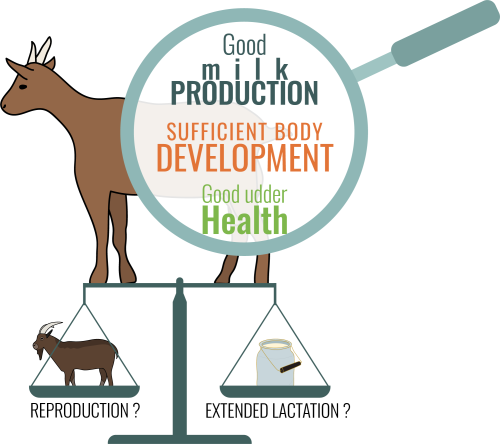
Any feedback from the field?
We have collected testimonies of breeders who use extended lactation on part of their herds, for different reasons and in different breeding contexts: Vanessa Boisdet and Wilfried Facoltet on the one hand, Aline de Bast on the other.
For 10 years, Vanessa Boisdet and Wilfried Facoltet have owned the Ferme de Bray, located in Martizay in Indre. With one employee, they manage 130 Alpine goats, 40 kids for herd renewal and 10 billy goats. They produce 80,000 liters of milk per year, which they transform entirely into AOP Pouligny Saint Pierre and Sainte Maure de Tourraine farmhouse cheeses.
Aline de Bast is a goat breeder in Barjon, Côte d’Or: she created the Ferme du Cul de Sac in 2014, after professional retraining, and currently leads a herd of 18 alpine goats. She produces 9000 liters of milk per year. See their testimonies in French.
Article written by the Chaire Bien-Être Animal, in collaboration with Bertrand Bluet, “Livestock Techniques and Environment” department of the Livestock Institute and Renée de Crémoux , “Product Quality, Welfare and Health” department of the Livestock Institute. For more information: www.idele.fr
[1] Fédération Nationale des Eleveurs de Chèvres, Chiffres clés de la filière caprine 2021
[2] Fédération Nationale des Eleveurs de Chèvres, Chiffres clés de la filière caprine 2021
[3]The mortality rate of kids between zero and two months is approximately 15%.
[4] CGAAER Rapport de mission de conseil n° 21026, septembre 2021. In the end, in 2017, nearly 300,000 kids were neither kept for herd renewal, nor slaughtered after fattening, which, according to the report, raises the question of their fate (self-consumption, uncontrolled slaughtering, informal sales channels, unreported early mortality, animals “retired” at birth).
[5] Fédération Nationale des Eleveurs de Chèvres, Chiffres clés de la filière caprine 2021.
[6] CGAAER Rapport de mission de conseil n° 21026, septembre 2021
[7] Due to reduced outlets while maintaining production level.
[8] CGAAER Rapport de mission de conseil n° 21026, septembre 2021
[9]The sporadic calls for the adoption of kids going to the slaughterhouse bear witness to this (200 kids up for adoption – France Bleue Armorique – March 2021). CGAAER Rapport de mission de conseil n° 21026, septembre 2021
[10] CGAAER Rapport de mission de conseil n° 21026, septembre 2021, page 32
[11] CGAAER Rapport de mission de conseil n° 21026, septembre 2021
[12] http://www.fnec.fr/IMG/pdf/Collection_Fiche_technique_lactations_longues.pdf
[13] CGAAER Rapport de mission de conseil n° 21026, septembre 2021
[14] In the majority of cases (90%), this involves extended lactation during the goat’s life.
[15] J.M. Astruc, C. de Boissieu, D. Buisson, V. Clément, R. de Crémoux, M. Doucet, H.Larroque, I. Palhière, R. Rupp, M. Arnal, N. Bossis, S. Coppin, J.M. Gautier, V. Gousseau, C. Jousseins, G. Lagriffoul, M. Legris, V. Loywyck, P. Martin, E. Morin, C. Robert-Granié, R. Rostellato, F. Tortereau « RUSTIC – Vers une approche intégrée de la robustesse des petits ruminants », Innovations agronomiques 82, 2021
[16] Y. Y. Suranindyah, Rochijan, B. P. Widyobroto and S. Dwi Astuti « Impact of Extended Lactation on Fatty Acid Profile and Milk Composition of Dual Purpose Tropical Goat », Pakistan Journal of Biological Sciences, Janvier 2020 ; A. A. K. Salama, G. Caja, X. Such, R. Casals, and E. Albanell « Effect of Pregnancy and Extended Lactation on Milk Production in Dairy Goats Milked Once Daily » Journal of Dairy Science, Décembre 2005
[17] P. Hassoun, Y. Lefrileux, N. Bossis et R. de Crémoux « Nouveautés dans les pratiques de traite des ovins et caprins : monotraite et lactations longues », Bulletin des GTV, Juillet-Août 2016
[18] P. Hassoun, Y. Lefrileux, N. Bossis et R. de Crémoux « Nouveautés dans les pratiques de traite des ovins et caprins : monotraite et lactations longues », Bulletin des GTV, Juillet-Août 2016
[19] Milk somatic cell count is an indicator of health quality. The higher the number of somatic cells in the milk, the greater the probability of udder contamination (and therefore infection).
[20] R. De Crémoux, N. Bossis, V. Clément, D. Ribaud « Conduite des chèvres en lactation longue : diversité des pratiques et incidence sur les concentrations cellulaires des laits », JNGTV Nantes, mai 2016
[21] P. Hassoun, Y. Lefrileux, N. Bossis et R. de Crémoux « Nouveautés dans les pratiques de traite des ovins et caprins : monotraite et lactations longues », Bulletin des GTV, Juillet-Août 2016
Keep in mind
- Lactation implies the birth of kids. However, the French do not eat much kid goat meat.
- Increasing lactation duration in goats may be useful for reducing the number of kid births while maintaining milk production
- Extended lactation in goats is also possible for other reasons, such as reproduction management, the distribution of milk production throughout the year, breeder work organization, etc
Key Figure
goat kids were born and reached the age of two months [3] in 2017

There are several benefits: first of all, there are fewer births, so for me, fewer kids to manage. Fewer births also mean less stress for me and the animals, and lower veterinary costs.

FERME DU CUL DE SAC

